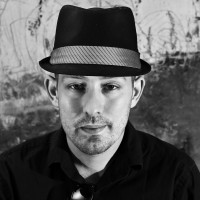The Man Behind the Movement
By the time he created artdc.org, photography had replaced science as number one in his life. Like any photographer, Cohen needed a place to work. In 2005, Stephen Mead, a local artist and fellow artdc collaborator found a space in the Northeast district of D.C. He immediately fell in love with it, and after seeing it, so did Cohen.
“There were concrete black walls, concrete ceilings; it was foul,” Cohen said. “We could sling paint around and drink beer and have a good time.”
For five years, that’s exactly what Cohen did. Six artists rented the space and each one had 150 square feet to use. There was also an open group area. Images of Andy Warhol’s factory are conjured up as Cohen talks about the unique people in the building and the neighborhood.
Prostitutes were mainstays in the neighborhood. For a case of beer, Sam, a homeless man, would watch your car. There were several groups of artists in the building. There was a paint-stripping factory in the basement, a nonprofit organization and a church on the first floor, another studio and a woodworking facility on the second floor with artdc, a banquet hall on the third, and a print shop on the fourth.
“It was what an art studio should be,” Cohen said. “I think it was motivation to make us work. There was a space waiting for us, brimming with creativity.”
In 2009, Cohen decided it was time for artdc to open a gallery. He collaborated with Jennifer McIvor, the marketing manager for EYA developers. After several months of brainstorming, the artdc gallery took shape. The gallery — which also houses a small studio — has hosted 32 shows representing D.C. artists. The main goal of the gallery is to do what so many galleries didn’t do for him: to give aspiring artists a chance.
“He knows SO many people, and he remembers so many details about them,” McIvor said in an e-mail. “He’s always thinking about how to introduce people for new opportunities and partnerships.”
Cohen’s work is hardly finished. He said there’s still more that could be done to further the movement. Compared to 2004 though, the art scene is much brighter. Cohen is no longer angry with Washington D.C.
“Things are happening now,” Cohen said. “There’s more activism. There are people trying to make things happen.”


